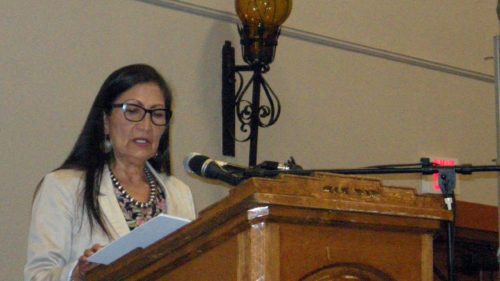(This story first appeared in the Spring 2014 Outdoor Reporter)
By Colleen RIchardson and Joel Gay
When you think of game species in the West, the mule deer is an iconic representation of western hunting and heritage. With their large distribution and popularity among hunters, Odocoileus hemonious is one of the most economically and socially significant animals in New Mexico.
But visit any sporting goods store from Farmington to Carlsbad and ask how muleys are doing and you’ll hear the same thing: “Terrible.”
Many mule deer populations in the state, especially in the southern mountains, have dropped steadily for a number of years. Unfortunately, said Stewart Liley, big game biologist for the Department of Game and Fish, “I don’t think we’ve necessarily seen the bottom yet.”
The Department estimates New Mexico has 80,000 to 100,000 mule deer and another 10,000 to 15,000 Coues and Texas white-tails. More than 36,000 hunters had deer licenses in the 2012-13 hunting season, and together they harvested 10,099 animals.
In the 2013-14 season, the number of available licenses dropped to just over 35,000, and Game and Fish is proposing to cut the number even further next rule cycle, which will cover the 2015-16 season to the 2018-19 season.
All wildlife populations fluctuate and mule deer are no exception. But even now, after years of decline, New Mexico has seen worse times. Nationwide, mule deer populations bottomed out in the early 1900s due largely to habitat degradation and overhunting. One estimate put the total national population as low as 40,000 animals. The total deer harvest in Carson National Forest in 1915 was just eight animals.
With the support of sportsmen’s organizations like the New Mexico Game Protective Association (later the New Mexico Wildlife Federation) as well as better land management practices by state and federal agencies and broad, public wildlife conservation efforts, muley stocks eventually bounced back. By the 1950s, they hit an estimated 250,000 nationwide.
In the 1960s and early ‘70s, New Mexico mule deer may have hit their peak, but hunters probably shouldn’t expect to see those levels again. That was a period in which widespread use of poisons like 1080 and strychnine artificially depressed predator numbers for decades, benefiting not only ranchers but hunters. “Those days are over,” Liley said.
Since poison use in the U.S. was reined in, coyotes, mountain lions and other predators have bounced back, and now predation is seen as another factor in today’s depressed deer populations, Liley said. “We’re trying for a more balanced approach in managing both predators and their prey,” he said, in which large predators have a place in the landscape, “but we definitely want to see higher numbers of deer in certain places.”
But other factors have played a key role in the slow decline of mule deer in New Mexico, and weather is a major factor. “Moisture is critical,” Liley said, which means that today’s muley populations vary geographically in the state. Deer north of I-40 are generally doing better than those to the south, he said. His biggest concern is with arid mountain ranges, especially in southeastern New Mexico, such as the Guadalupes and Sacramentos.
And habitat goes hand in hand with precipitation. Due to the relatively small size of their rumen, deer require high levels of nutritious forage. While elk are generalist grazers that can live on lower quality of forage and have adapted to a wide range of conditions and vegetation, deer need quality forage typically found in early-stage plant communities such as green, leafy forbs and select brush species like mountain mahogany – species that thrive after fires, clear cuts, even plowed fields and landscaped lawns.
Game and Fish has two programs dedicated to improving wildlife habitat, the long-standing Habitat Stamp Program funded through the annual sale of the $5 Habitat Stamp and the Big Game Enhancement Program funded through the auction and raffle of 14 big game licenses. These programs generate $1.5 million to $2 million annually, and the funding goes directly to on-the-ground habitat improvement projects.
The Department’s Habitat Stamp and Enhancement Program partners in the BLM and U.S. Forest Service, and organizations like The Rocky Mountain Elk Foundation, combined spend nearly $1 million annually to improve deer habitat such as reducing pinon-juniper encroachment, cutting back old decadent browse to stimulate new, highly nutritious growth and controlled burns to open up forest canopies. Those projects are continuing and are increasing in part due to matching funds through the Pittman-Robertson’s Federal Aid in Wildlife Restoration Act, the federal excise tax on hunting sports-related goods.
Perhaps the most promising areas for mule deer are the sites of big burns in recent years – the Sacramento, Gila, Black Range and Jemez mountains. “New growth is the best, most palatable, highest nutrition for a deer. If you get the right moisture, you get the best browse,” Liley said.
But those areas won’t be mule deer honey holes unless there are deer there to begin with. Unlike elk, which will migrate for miles, deer generally live and die in a fairly small area. “If the burn is not in their home range,” Liley said, “it’s hard to draw them in.” Only time will tell whether New Mexico’s massive fires – Whitewater Baldy, Las Conchas, Miller, Little Bear – will result in a bumper crop of muleys, he said.
That’s where transplant efforts could help. A few areas in New Mexico have too many mule deer, such as Silver City and Arabela, which presents an opportunity for Game and Fish to “stock” areas that have promising habitat but not enough native deer to take advantage of it.
The agency has been experimenting with deer transplant efforts and learned quite a bit in the last two years, Liley said. It appears that the highest success rates come from putting deer in areas with both good habitat and minimal predator pressure. In one test, 110 deer were trapped in Silver City, then transplanted to two sites more than 100 miles apart. The San Francisco River transplants had better habitat, but because mountain lion predation was substantial, just 58 percent of the transplants survived. The other group was placed in the Peloncillos, where cougars had been reduced to protect desert bighorns. Although the habitat was not as good, the overall survival rate was higher – 68 percent, even with a unavoidable summer mortality event of epizootic hemorrhagic disease or “blue tongue virus.”
And yet a third test, which took deer from Arabela to Chupadera Mesa, had less than 50 percent survival. Again, predation took a toll, even though the habitat was promising.
This year biologists are putting transplanted deer into two-acre protected enclosures for three weeks. Biologists hope these “soft release pens” will give the deer time to acclimatize to their new surroundings and develop “site fidelity.” “Deer have to learn their surroundings in order to survive. They need to learn where water sources are, where the best habitat is, and areas to avoid or escape predators” said Liley. Biologists have noticed following lion attacks that translocated deer tend to flee, sometimes to less suitable habitat. Therefore, he said, “predator control needs to be put into place before moving naïve deer into an area.”
Liley said he is hoping this year’s transplants will see even higher survival rates, perhaps 80 to 90 percent. More deer from Silver City and Arabela were dropped off in the Peloncillos and San Francisco River in February. Another 55 were transplanted to the Caballo Mountains, where mountain lion control has been done to protect bighorns and the habitat looks very good, Liley said.
“We’re really hoping to fine-tune our trap-and-transplant methods and find out what does and doesn’t work,” Liley said. The department is likely to focus on promising areas with low mule deer density rather than ranges like the Guadalupes and Sacramentos, where deer are well established.
In the meantime, hunters can expect to see mule deer opportunity decline, even as Game and Fish works on habitat improvement, transplants and targeted predator control. The license reductions actually started two years ago, as hunter satisfaction dropped and surveys showed falling deer numbers. GMUs 30 and 34, for example, were cut back from 2,500-3,000 rifle hunts annually to less than 2,000 each.
Of course, weather is the one factor that no one can control, and if the drought continues, it will affect all game animals from quail to bighorn sheep. “The questions is how we manage around that,” Liley continued. “What we’re hoping to do during these drought periods is determine what plants are critical and manipulate the landscape as best we can. We’re hoping that through time it improves not only deer populations but also hunting opportunity.”



